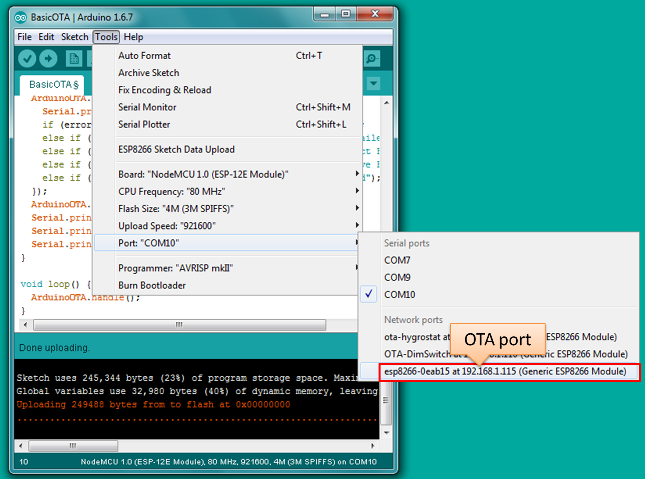

Have you selected correct ESP module type in Board menu? What is the selection? Is connected device responding to IDE? What is exact message in debug window? Is your module connected to serial port and visible in IDE? If this is still not the case, then review once more all discussed steps in the checklist below. Hopefully at this point you were able to resolve espcomm_sync failed issue and now enjoy quick and reliable uploads of your ESP modules.


#Arduino esp8266 serial port windows
If you prefer external terminal program, then for Windows users we can REST signal and you will see nothing on the Serial Monitor.Īs for different serial terminal program you can check Arduino IDE Otherwise the module will get stuck waiting for releasing the Use different serial terminal program that is not pulling down RTS andĭTR lines. Therefore after uploading module, you need to disconnect both lines or REST input of ESP, the module is hold in reset state / not able to run. After opening Serial Monitor (Ctrl-Shift-M), both RTSĪnd DTR lines are permanently pulled down. Presented circuit has one important limitation when it comes to work Resetting board trying to connect flush start setting serial port timeouts to 1 ms setting serial port timeouts to 1000 ms flush complete espcomm_send_command : sending command header espcomm_send_command : sending command payload read 0, requested 1 Selected in Arduino IDE, like different serial port, reset method, baud Analyze it for any anomalies to configuration you have Upload log may be longer depending on number of connection attempts madeīy esptool. starting app without reboot espcomm_send_command: sending command header espcomm_send_command: sending command payload espcomm_send_command: receiving 2 bytes of data closing bootloader flush start setting serial port timeouts to 1 ms setting serial port timeouts to 1000 ms flush complete Klippel setting board to ck setting baudrate from 115200 to 115200 setting port from COM1 to COM3 setting address from 0x00000000 to 0x00000000 espcomm_upload_file espcomm_upload_mem setting serial port timeouts to 1000 ms opening bootloader resetting board trying to connect flush start setting serial port timeouts to 1 ms setting serial port timeouts to 1000 ms flush complete espcomm_send_command: sending command header espcomm_send_command: sending command payload read 0, requested 1 trying to connect flush start setting serial port timeouts to 1 ms setting serial port timeouts to 1000 ms flush complete espcomm_send_command: sending command header espcomm_send_command: sending command payload espcomm_send_command: receiving 2 bytes of data espcomm_send_command: receiving 2 bytes of data espcomm_send_command: receiving 2 bytes of data espcomm_send_command: receiving 2 bytes of data espcomm_send_command: receiving 2 bytes of data espcomm_send_command: receiving 2 bytes of data espcomm_send_command: receiving 2 bytes of data espcomm_send_command: receiving 2 bytes of data Uploading 226368 bytes from to flash at 0x00000000 erasing flash size: 037440 address: 000000 first_sector_index: 0 total_sector_count: 56 head_sector_count: 16 adjusted_sector_count: 40 erase_size: 028000 espcomm_send_command: sending command header espcomm_send_command: sending command payload setting serial port timeouts to 15000 ms setting serial port timeouts to 1000 ms espcomm_send_command: receiving 2 bytes of data writing flash. Go to File > Preferences, enable Show verbose outputĭuring: upload and try uploading again. Next step to try, if not done already, is checking detailed debug


 0 kommentar(er)
0 kommentar(er)
